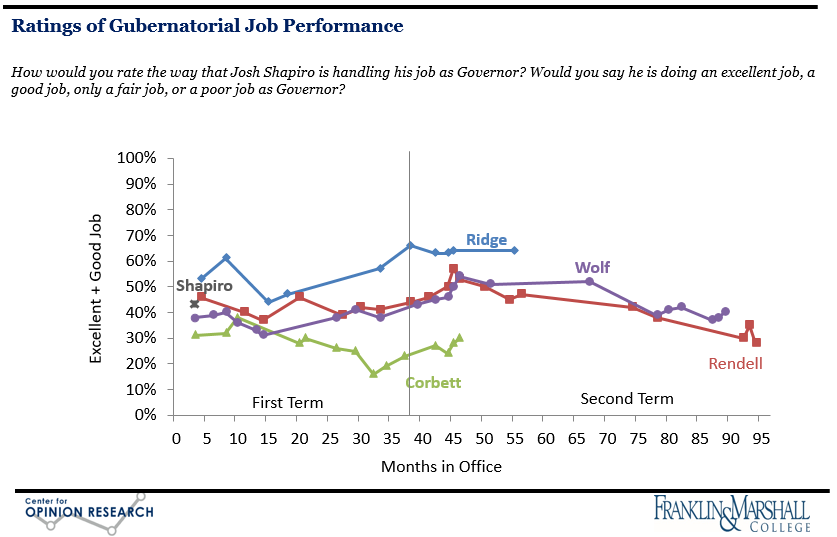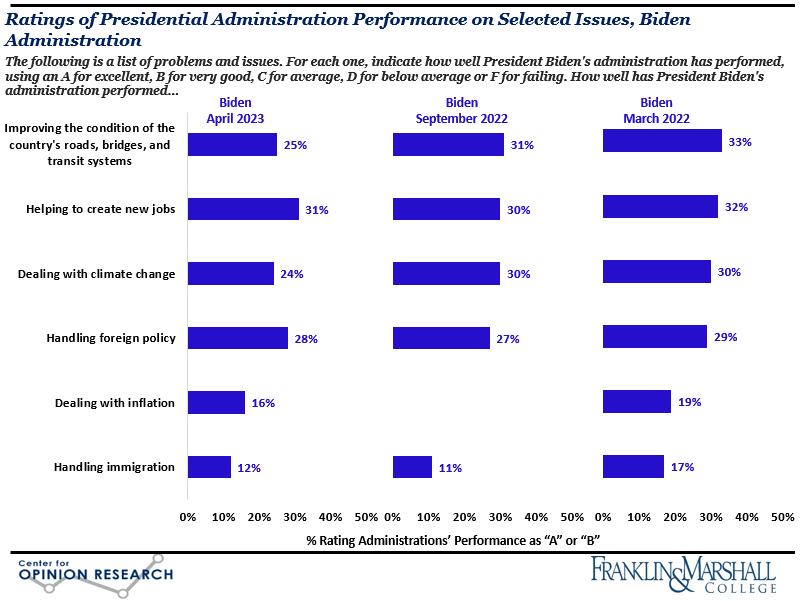Franklin & Marshall College Poll Release: April 2023
The first poll of the year explores the mood of Pennsylvania's voters, feelings about the economy, stands on issues like the death penalty, crime, basic education, elections, and ratings of state political figures.
Dear Readers,
I'm writing to share our summary report for the April 2023 Franklin & Marshall College Poll. I've highlighted a few of the key findings below, but I encourage you to read the full report, which is also included. The Poll explores the mood of the state's voters, their positions on issues like the death penalty, basic education, and elections, as well as their ratings of state political figures.
Thank you for reading,
Berwood Yost
Key Findings
The April 2023 Franklin & Marshall College Poll finds Pennsylvania’s registered voters are uneasy and mostly unmoved in their sentiments about the conditions of the state and its politics since last fall. Nearly half (46%) of respondents say they are “worse off” than a year ago while few (11%) say they are “better off” financially. One in three (33%) registered voters expects they will be “worse off” financially a year from now. These assessments of financial well-being are essentially unmoved since the 2022 midterms.
State Issues
Concern about the economy (22%), including unemployment and higher gas and utility prices, continues as the most important and often mentioned problem facing the state, but fewer people mention it as the state’s top problem than did so last fall (34%). Concerns about crime are more common now, rising to 19% from about 10% last fall. Democrats (23%) and independents (24%) are more likely than Republicans (13%) to say crime is a problem.
The survey also includes notable findings about state-level issues on the death penalty, education, and elections:
· More registered voters support (62%) than oppose (34%) the death penalty, consistent with prior data.
· Similar proportions of registered voters believe their local school districts have enough funding to prepare their students for life after high school (47%) as believe they do not have sufficient funding (44%). Similarly, voters are divided in their support for school vouchers, with equal proportions strongly supporting (31%) and strongly opposing (32%) such programs. On the other hand, most voters (63%) do not believe books or novels should ever be banned from school libraries.
· Fewer registered voters favor the use of mail-in ballots (50%) than supported their use prior to the 2020 election (59%), although most (57%) voters are “confident” their ballot would be counted properly if they used mail-in voting in an upcoming election.
Shapiro, Casey, and Biden Job Approval Ratings
More than two in five (43%) registered voters believe Josh Shapiro is doing an “excellent” or “good” job as governor. This is the highest initial approval ratings for a governor since Governor Rendell had a 46% positive approval rating early in his first term. Governor Shapiro has more positive ratings among Democrats (76%) and Independents (35%) than either Senator Casey or President Biden.

About one in four (29%) registered voters in Pennsylvania believe Bob Casey is doing an “excellent” or “good” job as their US Senator. Senator Casey’s ratings are a bit lower than his ratings in October 2018, prior to his last election, when he had a 43% positive job approval rating, although they are the same as his ratings in March 2011 (29%), about one year prior to his first re-election campaign. Despite his job approval ratings, Senator Casey leads prospective Republican candidates David McCormick and Doug Mastriano in head-to-head matchups. Casey leads McCormick 42% to 35%, while he leads Mastriano by a larger margin, 47% to 31%.
About one in four (27%) registered voters in Pennsylvania believe President Biden is doing an “excellent” or “good” job as president, although the President’s current rating is lower than President Trump’s and President Obama’s ratings in Pennsylvania at the same point in their terms. Despite this, he still holds an advantage in a head-to-head matchup against the former president, 36% to 35%, although it is also clear that many voters are looking for an alternative to both candidates.

Franklin & Marshall College Poll Newsletter
Join the newsletter to receive the latest updates in your inbox.
